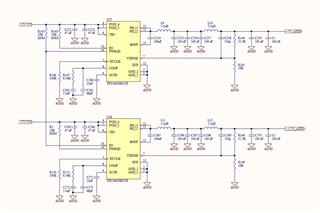Hello,
I've designed a system with two TPS54620, supplied by 12V.
The first device shoulde provide 5V output and the second one 2V5 output. The second device is enabled by the Power Good of the first.
You can see the complete schematic attached. DNM resistors are not mounted into the board.
There is a problem, the first device doesn't work, when I power on the board I hear a strong noise from the chip and there is a high current drain from power supply, very high (more then 500 mA, limited by the supply) with no load. I think the noise is an oscillation, but I don't explain the current drain with no load. I can't complete any measure with such level of current drain that could damage the chip or the board.
The second device is not enabled because the first doesn't work properly and there is no way to test it, without removing (destroying) the device, that is actually unavailable.
Please can you help me to fix the problem?
I don't see big mistakes on the schematic and the PCB is ok.


